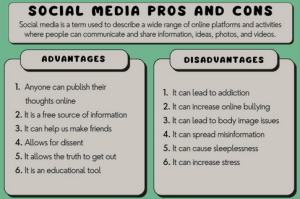Instagram, like any social media platform, has both advantages and disadvantages for teenagers. Here are the main pros and cons:

What are the Main Pros and Cons of Instagram for Teenagers?
Table of Contents
TogglePros:
- Social Connection:
- Pro: Instagram allows teenagers to connect with friends, family, and peers. It provides a platform for sharing experiences, staying in touch, and maintaining social connections.
- Creative Expression:
- Pro: Instagram provides tools for creative expression through photos, videos, and captions. Teenagers can showcase their talents, hobbies, and interests, fostering self-expression and building a personal brand.
- Community Building:
- Pro: Teenagers can join communities and interest groups on Instagram, connecting with like-minded individuals around the world who share similar passions.
- Visual Inspiration:
- Pro: Instagram is a source of visual inspiration. Teenagers can discover new ideas, trends, and perspectives by following accounts related to their interests, hobbies, and aspirations.
- Learning Opportunities:
- Pro: Instagram can be a platform for educational content. Teenagers can follow accounts that provide informative and educational content, contributing to their learning outside of formal educational settings.
- Networking:
- Pro: Instagram can be a valuable tool for networking. Teenagers can connect with peers, influencers, and professionals in their areas of interest, potentially opening up opportunities for collaboration or mentorship.
Cons:
- Social Comparison:
- Con: Instagram can contribute to social comparison and feelings of inadequacy. Teenagers may compare their lives, appearances, and achievements to those of their peers or influencers, leading to issues with self-esteem.
- Cyberbullying:
- Con: Cyberbullying is a serious concern on Instagram. Teenagers may face harassment, trolling, or negative comments, affecting their mental health and well-being.
- Addiction and Time Wasting:
- Con: Excessive use of Instagram can lead to addiction and time wasting. Teenagers may spend significant amounts of time scrolling through their feeds, potentially impacting academic performance and other responsibilities.
- Privacy Concerns:
- Con: Teenagers may not fully understand the privacy implications of their online activities. There are concerns about the sharing of personal information, location data, and the potential for privacy breaches.
- Inappropriate Content:
- Con: Instagram may expose teenagers to inappropriate or explicit content. Despite efforts to moderate content, there is a risk of encountering material that is not suitable for their age group.
- Negative Impact on Mental Health:
- Con: Instagram can contribute to mental health issues such as anxiety and depression. Constant exposure to curated and idealized images may create unrealistic expectations and standards.
- Distorted Self-Image:
- Con: The prevalence of filters and photo-editing tools on Instagram can contribute to a distorted self-image. Teenagers may feel pressure to conform to unrealistic beauty standards.
- Peer Pressure and Influencer Influence:
- Con: Teenagers may experience peer pressure to conform to trends and lifestyles promoted by influencers. The influence of influencers on purchasing decisions and lifestyle choices can be significant.
Tips for Responsible Instagram Use:
- Set Usage Limits:
- Encourage teenagers to set limits on their daily usage of Instagram to avoid excessive screen time.
- Promote Positive Interactions:
- Teach teenagers about responsible and positive online interactions, including reporting and blocking features for dealing with cyberbullying.
- Educate on Privacy Settings:
- Ensure that teenagers understand and utilize privacy settings on their accounts to control who can view their content.
- Encourage Offline Activities:
- Encourage a healthy balance between online and offline activities. Promote physical activities, hobbies, and face-to-face interactions.
- Open Communication:
- Foster open communication with teenagers about their experiences on Instagram. Create a safe space for them to discuss any concerns or challenges they may be facing.
- Model Responsible Use:
- Model responsible social media use as a parent or guardian. Demonstrate healthy online habits and set a positive example.
- Monitor Content:
- Be aware of the content teenagers are consuming on Instagram. Regularly check their accounts to ensure that they are not exposed to inappropriate or harmful material.
- Encourage Critical Thinking:
- Teach teenagers to critically evaluate content they encounter on Instagram, including recognizing the potential for photo manipulation and understanding the difference between curated online content and real life.
In summary, while Instagram can offer positive experiences for teenagers, it’s essential for parents and guardians to be aware of the potential drawbacks and actively guide responsible use. Open communication, education on privacy settings, and promoting a healthy balance between online and offline activities are crucial elements of fostering a positive social media experience for teenagers.
